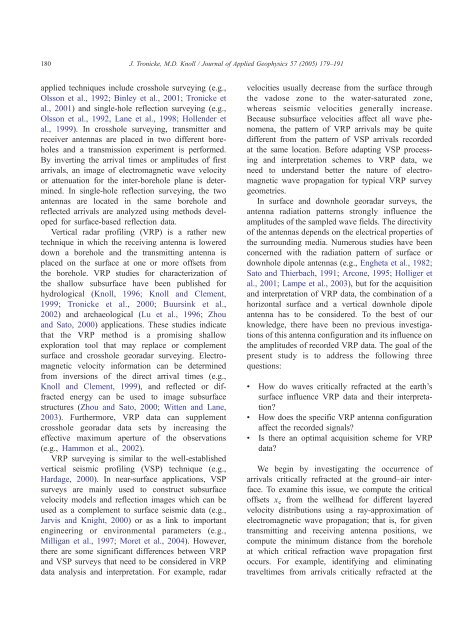Vertical radar profiling - CGISS - Boise State University
Vertical radar profiling - CGISS - Boise State University
Vertical radar profiling - CGISS - Boise State University
Create successful ePaper yourself
Turn your PDF publications into a flip-book with our unique Google optimized e-Paper software.
180<br />
J. Tronicke, M.D. Knoll / Journal of Applied Geophysics 57 (2005) 179–191<br />
applied techniques include crosshole surveying (e.g.,<br />
Olsson et al., 1992; Binley et al., 2001; Tronicke et<br />
al., 2001) and single-hole reflection surveying (e.g.,<br />
Olsson et al., 1992, Lane et al., 1998; Hollender et<br />
al., 1999). In crosshole surveying, transmitter and<br />
receiver antennas are placed in two different boreholes<br />
and a transmission experiment is performed.<br />
By inverting the arrival times or amplitudes of first<br />
arrivals, an image of electromagnetic wave velocity<br />
or attenuation for the inter-borehole plane is determined.<br />
In single-hole reflection surveying, the two<br />
antennas are located in the same borehole and<br />
reflected arrivals are analyzed using methods developed<br />
for surface-based reflection data.<br />
<strong>Vertical</strong> <strong>radar</strong> <strong>profiling</strong> (VRP) is a rather new<br />
technique in which the receiving antenna is lowered<br />
down a borehole and the transmitting antenna is<br />
placed on the surface at one or more offsets from<br />
the borehole. VRP studies for characterization of<br />
the shallow subsurface have been published for<br />
hydrological (Knoll, 1996; Knoll and Clement,<br />
1999; Tronicke et al., 2000; Buursink et al.,<br />
2002) and archaeological (Lu et al., 1996; Zhou<br />
and Sato, 2000) applications. These studies indicate<br />
that the VRP method is a promising shallow<br />
exploration tool that may replace or complement<br />
surface and crosshole geo<strong>radar</strong> surveying. Electromagnetic<br />
velocity information can be determined<br />
from inversions of the direct arrival times (e.g.,<br />
Knoll and Clement, 1999), and reflected or diffracted<br />
energy can be used to image subsurface<br />
structures (Zhou and Sato, 2000; Witten and Lane,<br />
2003). Furthermore, VRP data can supplement<br />
crosshole geo<strong>radar</strong> data sets by increasing the<br />
effective maximum aperture of the observations<br />
(e.g., Hammon et al., 2002).<br />
VRP surveying is similar to the well-established<br />
vertical seismic <strong>profiling</strong> (VSP) technique (e.g.,<br />
Hardage, 2000). In near-surface applications, VSP<br />
surveys are mainly used to construct subsurface<br />
velocity models and reflection images which can be<br />
used as a complement to surface seismic data (e.g.,<br />
Jarvis and Knight, 2000) or as a link to important<br />
engineering or environmental parameters (e.g.,<br />
Milligan et al., 1997; Moret et al., 2004). However,<br />
there are some significant differences between VRP<br />
and VSP surveys that need to be considered in VRP<br />
data analysis and interpretation. For example, <strong>radar</strong><br />
velocities usually decrease from the surface through<br />
the vadose zone to the water-saturated zone,<br />
whereas seismic velocities generally increase.<br />
Because subsurface velocities affect all wave phenomena,<br />
the pattern of VRP arrivals may be quite<br />
different from the pattern of VSP arrivals recorded<br />
at the same location. Before adapting VSP processing<br />
and interpretation schemes to VRP data, we<br />
need to understand better the nature of electromagnetic<br />
wave propagation for typical VRP survey<br />
geometries.<br />
In surface and downhole geo<strong>radar</strong> surveys, the<br />
antenna radiation patterns strongly influence the<br />
amplitudes of the sampled wave fields. The directivity<br />
of the antennas depends on the electrical properties of<br />
the surrounding media. Numerous studies have been<br />
concerned with the radiation pattern of surface or<br />
downhole dipole antennas (e.g., Engheta et al., 1982;<br />
Sato and Thierbach, 1991; Arcone, 1995; Holliger et<br />
al., 2001; Lampe et al., 2003), but for the acquisition<br />
and interpretation of VRP data, the combination of a<br />
horizontal surface and a vertical downhole dipole<br />
antenna has to be considered. To the best of our<br />
knowledge, there have been no previous investigations<br />
of this antenna configuration and its influence on<br />
the amplitudes of recorded VRP data. The goal of the<br />
present study is to address the following three<br />
questions:<br />
! How do waves critically refracted at the earth’s<br />
surface influence VRP data and their interpretation<br />
! How does the specific VRP antenna configuration<br />
affect the recorded signals<br />
! Is there an optimal acquisition scheme for VRP<br />
data<br />
We begin by investigating the occurrence of<br />
arrivals critically refracted at the ground–air interface.<br />
To examine this issue, we compute the critical<br />
offsets x c from the wellhead for different layered<br />
velocity distributions using a ray-approximation of<br />
electromagnetic wave propagation; that is, for given<br />
transmitting and receiving antenna positions, we<br />
compute the minimum distance from the borehole<br />
at which critical refraction wave propagation first<br />
occurs. For example, identifying and eliminating<br />
traveltimes from arrivals critically refracted at the
















